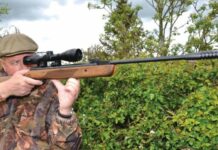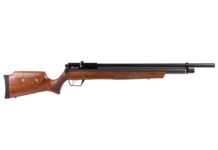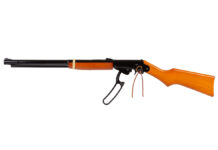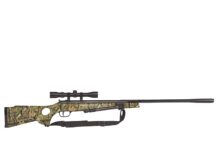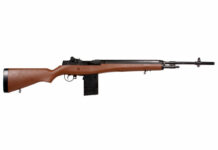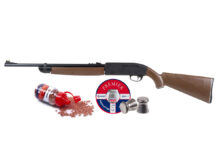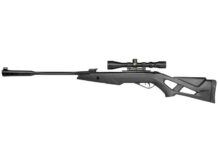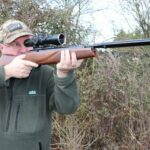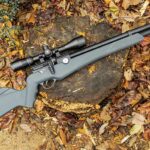The former American president, Joe Biden, was recently quoted saying:
If you need more than ten rounds to hunt, you better stop that business and get to something else
Many people claim that they use many rounds.
If you can’t eliminate the deer in 3 shots, you are one great embarrassment.”
Well, regardless of your political standing, that’s food for thought.
I suppose one factor that affects the prowess of hunters is their mastery of the airgun sights.
After all, you must accurately sight what you are hunting to increase your chances of hitting the target.
Having the best hunting air rifle is not enough to bag that choice.
So let’s explore some common airgun sights and get to know their advantages and disadvantages.
Table of Contents
The role of airgun sights
Surfing through Pyramyd Air, I recently saw a scope priced at 1099.99 USD.
To be precise, I’m referring to the Falcon Optical Systems 10-50×60, X50 Field Target Riflescope.
On the other end of the divide is the Crosman 0410 Targetfinder Rifle Scope priced at an incredible 11 USD.
Such a difference in prices! But be sure, whether you spend a thousand bucks or ten bucks on a scope, the principle remains the same.
The airgun sight basically allows you to point the barrel of your air rifle in a specific direction
So that the pellet flies through the air in a trajectory that increases your chances of hitting the target.
That’s the basic scope knowledge for dummies right there.

Types of air rifle sights
1. Open Sights
I bet it helps to know that the very first guns never had sighted.
They weren’t even referred to as guns.
Their name then was hand cannons.
These were not that accurate.
Aiming at one man standing some 10 meters away was in fact a problem.
The weapons could miss quite obvious targets many times over.
Technology advanced and our ancestors saw the need to add sights to the guns.
The first one was of course the open sights.
You can call them iron sights if you wish.
These are further classified into two: foresight and rear sights.
The first guns had only the foresight, which is fixed near the front end of the barrel.
The rear sight is installed near the eye of the shooter.
The sights usually have a V-shaped or rectangular cutout.
The idea is to align a small post or bead at the front end of the barrel inside the cutout.
This way, the air rifle points directly towards the target and the ammo is more likely to hit the target.
Pros of open sights
- Can prove very accurate if you take the time to master their use
- Budget-friendly
- Comes included in most air rifles
- Little to no maintenance required
Cons of open sights
- Takes some time to aim for beginners
- Looks quite simple for the sophisticated nature of most humans
- Does not favor shooters with eyesight problems
- Difficult to use in poor light environments.
2. Aperture sights
Note that the principle of airgun sights remains the same.
The aperture sights are very similar to the open sights.
The only difference is that the aperture sight uses a fully enclosed element for the rear sight whereas the open sight uses a notch.
Other airgunners refer to it as the diopter sight.
Designers have tried to make use of human nature by combining a circular front sight with a circular rear aperture sight.
It becomes easy for most hunters to fit a circle within a bigger circle.
3. Optic sights
These can also be referred to as telescopic sights or simply, ‘tele’.
They are also more popularly known as scopes.
The name tells you its operation closely resembles that of a real telescope.
As such, it consists of two lenses, the front, and the rear.
The front lens, also known as the objective lens, allows light into the scope.
The rear lens, also known as the ocular lens, is the one into which the shooter looks.
Conventionally, both the front and rear ends of the scope are widened to house the lenses.
The two lenses are connected through a narrowed cylinder referred to as the tube of the scope.
Scope tubes are mostly designed to be 25 mm or 30 mm in diameter.
The 1-inch tube dominated the market for decades until manufacturers saw the need for a larger tube to accommodate bigger lenses which are better.
Some have even gone a step further and made scopes with a 34 mm scope tube – e.g. the Discovery HD 3-18X50 FFP SS.
The scope tube houses reticles.
Perhaps a more familiar term is the crosshairs.
Again, there are quite a variety of reticles to choose from.
It all depends on how you are wired.
a. Fine crosshair
This must be the simplest of all, in that it comprises two thin lines intersecting at the center of the field of view.
With this, you can view a larger part of the target without obstruction.
The only downside is that the thin crosshairs may be difficult to view when the target is somewhat dark.
However, they work well in high contrast backgrounds – think of bright targets like a yellow metal plate or a bright green soda can.
To solve the problem of sighting against dark backgrounds, some manufacturers illuminate the reticles with battery power to bright colors such as red, green, or blue.
You can then comfortably switch to the color you see best against the current background.
b. Duplex crosshair
Considering the disadvantages of the fine crosshairs, designers thought of thickening the hairs along the periphery of the field of view and leaving the hairs thin around the intersection.
This can be more easily seen in dark backgrounds.
c. Mil-dot
This is a modification of the duplex crosshair.
Small dots are added to the thin hairs towards the intersection, simply to boost visibility against dark backgrounds.
Ted’s HoldOver shows you how to use the mil-dot reticle to determine the distance to your target here:
d. Target dot
This is a modification of the fine crosshairs with a dot added at the center.
The center dot is meant to rest at the center of the target.
This improves the fine crosshairs but it may not prove useful where the target is very small, as the dot is likely to cover the entire target.
c. Circle
Instead of the center dot described above, this comprises a full circle around the intersection of the crosshairs.
This is meant to improve visibility but has the unexpected effect of cluttering the target.
Pros of optic sights
- Perfect for long-range hunting
- Perfect for tiny targets
- Comes in fixed and variable varieties
- Hundreds of options to choose from
- Easy to use
Cons of optic sights
- Can prove difficult to use if the target keeps moving
- Adjustment settings change quickly with every turn of the several knobs
Other variations
From the basic optic sights with front and rear lens and reticles, designers have added a whole battalion of features to scopes to enhance the hunter’s experience.
Let us look at some of these.
Lasers
These basically project a beam with the aim to assist in rangefinding.
A rangefinder calculates the exact distance between you and the target and additionally presents a crystal-clear image of the target
So that you are not left guessing what you are aiming at.
It enables you to pull the trigger with a high degree of surety.
Pros
- Great for situations where you are likely to be jerked out of the shooting position
- Gives you a perfect aim at the target in the shortest time possible
Cons
- Makes new shooters poor at aiming
- Visibility problems arise when the sun shines too brightly
Red dot sight
A red dot sight likewise allows the hunter to view a holographic sight picture of the target within the optic.
It becomes quite easy to place the red dot right on the target.
One important feature of red dot sights is the magnification power.
Depending on the model, you are able to enlarge the target up to sixteen times, or even eighty times for more advanced scopes.
All this does is provide a clearer picture of the target – you see the stomach, head, shoulders, legs, back, etc.
You then narrow down to the specific part you are interested in and pull the trigger with higher chance of hitting the intended part.
To adjust the magnification power, you simply need to rotate the power ring to the desired magnification level.
You will mostly find the power ring at the rear end of the scope near your eye.
Additionally, most scopes with magnification ability come with the ocular focus ring.
This is used to ensure the reticle is in focus, however far or near the target is.
And now to the two variations of scopes in regards to magnification ability:
- Variable scopes – This is what we just discussed. You can alter the magnification power to a value of your choice, basically by rotating an adjustment knob.
- Fixed scopes – These do not allow you to change the magnification. For this reason, you better use them for targets that are not too far away – preferably for plinking and target shooting practice. If used for hunting, ensure that the prey is at close range.
As much as they seem limited, fixed scopes have the one advantage of requiring no adjustment once they are mounted.
Pros of Red Dot sights
- Can be used for varying light conditions
- The prey can’t view the red dot and so will never know it’s being aimed at.
Cons of red dot sights
- With hundreds of brands and models to choose from, you feel confused right away
- Can prove a bit pricey if you fancy more advanced features
Fiber optic sights
The crosshairs for this sight are made of an optical fiber that is transparent and flexible, usually of a diameter next to that of human hair.
The optical fiber allows light to pass through it, thus enhancing the visibility of the target.
It is interesting how optical fibers interact with light.
They’re usually made from an inner core and outer covering.
Both the inner and outer components have a low refractive index, implying that they do not bend light.
However, the outer covering has high reflectivity, so it reflects light along its entire length.
Even in conditions of poor light, the optical fiber is able to pick up the little light and transmit it along the full length of the cable.
This makes it ideal for foresight.
You can place the well-lit fiber on the target without much problem.
As such, they find great use in low-light settings.
Better still, they come in two main colors – red and green.
Which one strikes a chord with you? Go for it!

In case your eyes are not that good, consider purchasing a fiber-optic sight with a bigger circumference.
At least you won’t strain a lot.
Here is a list of some popular air rifles that come bundled with fiber optic sights:
- Hatsan 95 Air Rifle Combo
- Umarex NXG APX Air Rifle Combo
- Bear River Sportsman 900 Air Rifle – Multi-Pump .177 Airgun
- Ruger Explorer Youth .177 Caliber pellet Airgun
- Hatsan Model 95
- Crosman 2100X Classic
- Crosman 764 SB rifle
- Ruger Air Magnum
Pros
- Works great for quick shooting
- Great for beginner shooters who are just starting out
- Very useful in poor light conditions
- Budget-friendly
- Have easy-to-change rods
Cons
- Some are fragile – you can easily break the glass tubes
- Fiber optic rods may be affected by a number of cleaning solutions – with some like acetone bleaching the rod
Understanding scope models
You can get easily confused by the numerous numerical numbers you see on different scope models.
Take the example of the CenterPoint 6-20X50 AO Rifle Scope.
The numbers 6-20 mean that you can magnify the target 6-20 times, while the number 50 points to the size of the objective lens in mm.
The larger the objective lens, the larger the objective bell.
You need this information before you make the purchase so that you can ensure the scope will fit onto the mounting rails of your air rifle.
In addition to that, the bigger the lens, the stronger the magnification.
Go for the largest objective lens if you intend to go hunting at dusk or dawn.
Lastly, AO means Adjustable Objective, implying that the adjustment feature for parallax is fitted onto the objective bell of the scope.
You will also find some scopes with the suffix AOE – lightly meaning Around the Objective End.
Other terms you may come across in scopes include:
- IR – Illuminated reticle
- SF – Side Focus – the turret for adjustment of parallax is mounted on one side of the scope tube.
- HD – High Definition
- MOA – Minute of angle – refers to the accuracy of groupings at a particular range. MOA is actually 1/60th of a degree. 1 MOA implies groupings of 1” at 100 yards.
- SWAT – Special weapons and tactics
Air rifle scopes vs firearm scopes
It would seem an incredible hack to simply mount your old firearm scope onto your new air rifle.
Don’t! Air rifle scopes are specially designed to counteract the unique vibration and double recoil of airguns.
As a matter of fact, spring-powered airguns require especially rated air rifles that can withstand the sometimes high recoil.
Springers are known to easily damage other scopes.
Frequently Asked Questions
1. What is a 6 o’clock sight picture?
There are quite a number of sight pictures that shooters use to improve their shooting accuracy.
This is especially so if you are working with open sights.
Sight pictures are obtained by aligning the rear and front sights in a specific relationship with the target.
The best one is that which allows you to have the smallest groupings.
Some of the popular sight pictures are elaborated below:
- Center hold – this involves placing the front sight directly in the center of the target.
- 6 O’clock – this involves placing the front sight at the lower part of the aiming black.
- Sub 6 – this favors those shooters who experience difficulties with the 6 O’clock hold by including a small white line between the front sight and the aiming black.
- Frame hold – this involves placing the front sight at the center of the rear sight. In case there is no distinct aiming point, the front sight can be adjusted to the 6 or 12 O’clock position. This works quite well in low-light settings.
2. Why should you aim with your dominant eye?
Think of it this way – you are either left-handed or right-handed.
If left-handed, your dominant hand is the left one, with which you easily handle many tasks.
The opposite is true for right-handed persons.
This concept also applies to the eyes.
FYI, One of your eyes is stronger than the other.
In most cases, right-handed persons have the right eye as the dominant one
But there are instances where the dominant eye can be the opposite of the dominant hand.
To know your dominant eye, Hunter-Ed proposes the 5 steps below:
- Use your four fingers and the thumb to create a triangular opening.
- Extend the arms away from your eyes.
- Try looking at a far object through the opening with both eyes open.
- Gradually pull the arms towards your eyes, ensuring your focus on the object does not waver.
- The opening will naturally land on your dominant eye.
- You may also try closing one eye at a time.
- The dominant eye tends to remain focused on the object while the other eye sees the back of your hands.
To keep your shooting as accurate as possible, always use the dominant eye.
I am right-handed and my right eye is dominant. What about you?
3. What is proper sight alignment?
Sight alignment is basically the link between the front and rear sights.
You ideally peep through the rear sight with the intention of seeing the front sight right at the center.
On the other hand, the sight picture refers to the link between the aligned sights and the aiming bull on the target, which may be in the form of a post or bead.
Before I sign off, I’ll add yet another term for your keeps – eye relief. This refers to the distance between your eye and the rear sight.
You should master keeping a relatively constant distance between your eye and the sight.
You don’t want to bump the sight with your eye or place it very far away.
As a rule of thumb, aim at a minimum of 2 inches, and don’t go beyond 5 inches.




